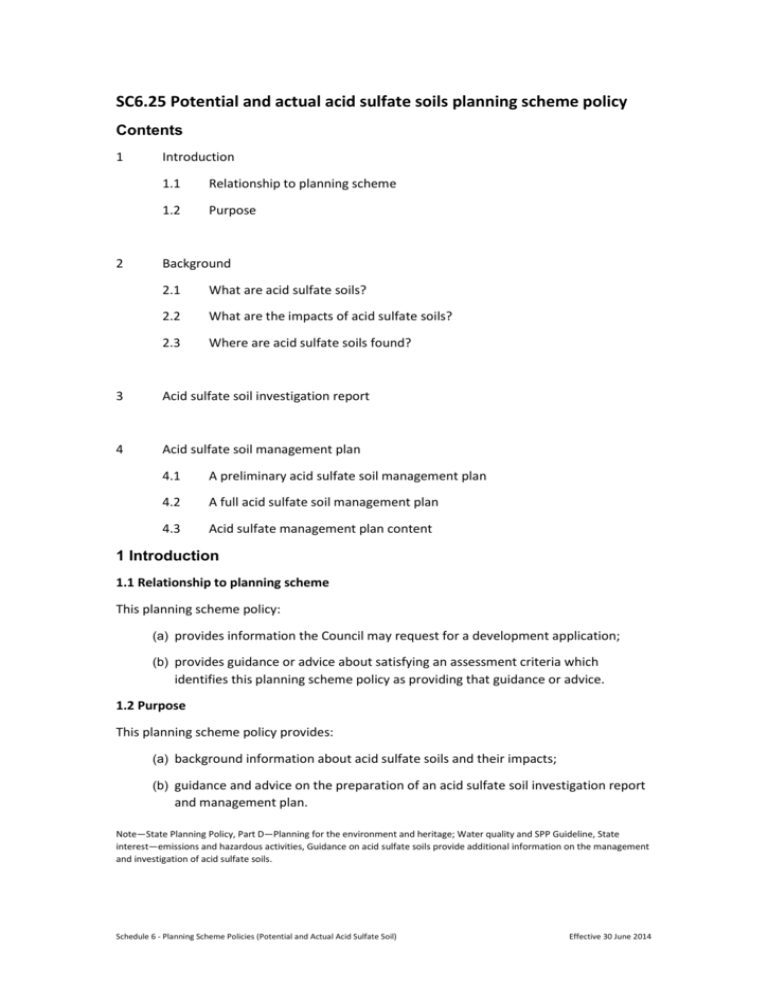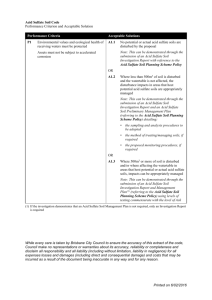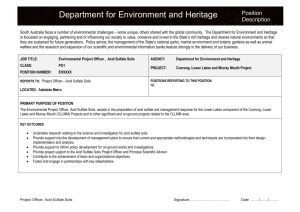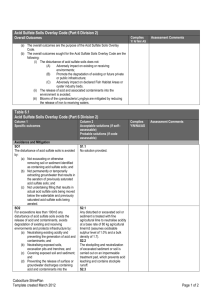Potential and actual acid sulfate soils planning scheme policy
advertisement

SC6.25 Potential and actual acid sulfate soils planning scheme policy Contents 1 2 Introduction 1.1 Relationship to planning scheme 1.2 Purpose Background 2.1 What are acid sulfate soils? 2.2 What are the impacts of acid sulfate soils? 2.3 Where are acid sulfate soils found? 3 Acid sulfate soil investigation report 4 Acid sulfate soil management plan 4.1 A preliminary acid sulfate soil management plan 4.2 A full acid sulfate soil management plan 4.3 Acid sulfate management plan content 1 Introduction 1.1 Relationship to planning scheme This planning scheme policy: (a) provides information the Council may request for a development application; (b) provides guidance or advice about satisfying an assessment criteria which identifies this planning scheme policy as providing that guidance or advice. 1.2 Purpose This planning scheme policy provides: (a) background information about acid sulfate soils and their impacts; (b) guidance and advice on the preparation of an acid sulfate soil investigation report and management plan. Note—State Planning Policy, Part D—Planning for the environment and heritage; Water quality and SPP Guideline, State interest—emissions and hazardous activities, Guidance on acid sulfate soils provide additional information on the management and investigation of acid sulfate soils. Schedule 6 - Planning Scheme Policies (Potential and Actual Acid Sulfate Soil) Effective 30 June 2014 2 Background 2.1 What are acid sulfate soils? (1) An acid sulfate soil is the common name given to soils containing iron sulfides (usually pyrite, FeS2) that, if oxidised, produce sulfuric acid. When exposed to air, either naturally such as during a drought, through soil disturbance such as dredging or excavation, or through a lowered watertable such as drain construction, the sulfides oxidise to produce sulfuric acid. Disturbing acid sulfate soils can therefore result in soil and groundwater becoming acidic. (2) Potential acid sulfate soils are soils that have the potential to oxidise and produce sulfuric acid. These soils typically exist in a waterlogged environment such as below the watertable, where the sulfides are prevented from reacting with oxygen in the air. (3) Actual acid sulfate soils are those acid sulfate soils that have been exposed to oxygen in the air and the sulfuric acid produced is in excess of the soil buffering capacity. The resulting acid may acidify the soil, groundwater or surface waters. 2.2 What are the impacts of acid sulfate soils? Acidic drainage from acid sulfate soils can cause significant harm to the environment, important fisheries and corrodible assets. For example, acidic drainage can: (a) dissolve iron, aluminium, manganese and other heavy metals in the soil that may then be taken up by plants and animals and potentially killing them; (b) significantly degrade important aquatic habitats, including fisheries; (c) contribute to an increase in fish mortality, disease such as red spot disease and algal blooms; (d) reduce the biodiversity in the city’s waterways and wetlands; (e) corrode infrastructure containing concrete and metal such as culverts, bridges and stormwater drains. 2.3 Where are acid sulfate soils found? (1) In Brisbane, acid sulfate soils are generally found below 5m AHD and more commonly below 2m AHD and in Holocene sediments which are organic-rich muds and silts formed in the last 7,000 years on coastal lowlands and estuarine floodplains. (2) Potential or actual acid sulfate soils to which the Potential and actual acid sulfate soils overlay code and this planning scheme policy apply, are identified on the Potential and actual acid sulfate soils overlay map. 3 Acid sulfate soil investigation report (1) An acid sulfate soil investigation report is to: (a) explain the methodology and findings of an investigation to determine the extent and severity of acid sulfate soils on a site; (b) evaluate the potential for harm to the environment or to constructed assets as a result of the development; Schedule 6 - Planning Scheme Policies (Potential and Actual Acid Sulfate Soil) Effective 30 June 2014 (c) make recommendations as to whether management measures are needed. (2) An acid sulfate soil investigation is to be undertaken: (a) very early in the proposed development’s life, as the findings may significantly influence issues such as design, timing, and the financial viability of the project; (b) in accordance with current and locally applicable technical guidelines, including SPP Guideline, State interest—emissions and hazardous activities, Guidance on acid sulfate soils and Queensland Acid Sulfate Soils Technical Manual; (c) by an appropriately qualified and experienced person. (3) If the acid sulfate soil investigation report finds that acid sulfate soils will be affected by the development, then an acid sulfate soil management plan is to be prepared. 4 Acid sulfate soil management plan An acid sulfate soil management plan is to: (a) explain how acid sulfate soils will be managed on the site to minimise or prevent harm to the environment or to constructed assets; (b) be consistent with current State Government technical guidelines for the assessment and management of acid sulfate soils. 4.1 A preliminary acid sulfate soil management plan A preliminary acid sulfate soil management plan is to be prepared when the development will disturb less than 500m3 of soil and the watertable is not affected. Note—The intent of this form of plan is to ensure that development is not unreasonably delayed when small amounts of acid sulfate soil are disturbed, groundwater is not affected, and therefore there is low potential for environmental harm or significant corrosion of assets as a result of acid sulfate soil disturbance. The preparation of a preliminary acid sulfate soil management plan may occur as a condition of approval, prior to the commencement of site works. 4.2 A full acid sulfate soil management plan A full acid sulfate soil management plan is to be prepared when the development will disturb greater than 500m3 of soil or the watertable is affected. Note—The preparation of an acid sulfate soil management plan is to occur prior to the issuing of a development approval. 4.3 Acid sulfate soil management plan content (1) An acid sulfate soil management plan, either full or preliminary, is to include: (a) at least a two-dimensional map of the potential acid sulfate soils to at least the depth of disturbance; (b) details that reflect potential on-site and off-site impacts of the disturbance on the soil and the groundwater levels; (c) the methods that will be used to avoid, treat or otherwise manage acid sulfate soils, including the contained on-site management and treatment of potential and actual acid sulfate soils; Schedule 6 - Planning Scheme Policies (Potential and Actual Acid Sulfate Soil) Effective 30 June 2014 (d) details of the management of the height of the groundwater table on-site and off- site both during and after construction; (e) details of all soil and water monitoring, both manual and automated, to be performed during and after treatment, and including verification testing of soils; (f) details of handling and storage of neutralising agents; (g) details of contained on-site treatment and management of potentially contaminated stormwater run-off, and leachate including details of groundwater management associated with the works both in the short and long term; (h) a description of contingency measures to be implemented on and off the site if the management procedures prove to be unsuccessful and acid is generated or leachate problems occur; (i) details of the treatment and management of surface drainage waters for disturbed acid sulfate soils. (2) The acid sulfate soil management plan is to provide for the ongoing management and monitoring of impacts of acid sulfate soil material throughout the construction and operation of the project and describe the construction schedules and environmental management procedures. The development is to be staged so that the potential impact of any area disturbed at any one time is limited and easily managed. (3) Action is to be taken to prevent or minimise any adverse impacts on surface water, groundwater, the site and surrounding areas. These actions are to be documented in the acid sulfate soil management plan and include: (a) objectives and outcomes; (b) management measures; (c) performance indicators; (d) elements to be monitored; (e) a monitoring schedule; (f) contingency plans; (g) responsibilities; (h) reporting and review requirements; (i) training arrangements. Schedule 6 - Planning Scheme Policies (Potential and Actual Acid Sulfate Soil) Effective 30 June 2014








